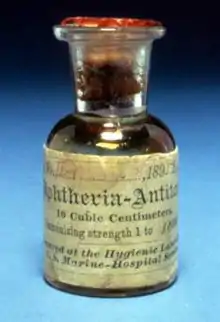Diphtherie-Antitoxin
Das Diphthterie-Antitoxin (DAT) ist ein Antitoxin gegen das Diphtherietoxin von Corynebacterium diphtheriae. Das Diphtherie-Antitoxin befindet sich auf der Liste der unentbehrlichen Arzneimittel der Weltgesundheitsorganisation.[1]

Eigenschaften
Der wirksame Bestandteil des Diphthterie-Antitoxins sind neutralisierende Antikörper. Es wird beim Menschen als passive Immunisierung zur Behandlung von Diphtherie angewendet.[2] Eine Ampulle besteht aus 10.000 Injektionseinheiten in einem Milliliter steriler wässriger Lösung, die intravenös oder intramuskulär injiziert werden (Stand 2018).[2] Das Diphtherie-Antitoxin wird aus dem Blutserum von Pferden gewonnen, die zuvor mit dem Diphtherie-Toxin immunisiert wurden.[2]
Mögliche Nebenwirkungen sind Serumkrankheit sowie allergische Reaktionen bis hin zur Anaphylaxie. In der EU ist es nicht ständig und überall verfügbar.[3] Das Diphtherie-Antitoxin wird in den USA unter dem Investigational New Drugs Protokoll angewendet, da es keine Arzneimittelzulassung besitzt.[2] Es wird zudem als Vergleichsstandard und Positivkontrolle bei der Messung von menschlichen Antikörpern gegen das Diphtherie-Toxin verwendet.[4]
Alternativ kann teilweise der humane monoklonale Antikörper 315C4 oder Antikörper aus Seren von Rekonvaleszenten zur passiven Immunisierung gegen das Diphtherietoxin verwendet werden.[5][6]
Geschichte
Eine Immunisierung gegen C. diphtheriae wurden erstmals 1890 von Emil von Behring und Shibasaburo Kitasato durch passive Immunisierung erreicht und als Serumtherapie beschrieben.[7] Emil von Behring erhielt dafür 1901 den Nobelpreis für Physiologie oder Medizin. Ab 1895 wurde das Diphtherie-Antitoxin regelmäßig beim Menschen angewendet. Eine Einheit wurde von Paul Ehrlich als die Dosis zur Neutralisation einer für Meerschweinchen tödlichen Dosis an Diphtherie-Toxin definiert.[8][9] Seit der Entwicklung eines vorbeugenden Diphtherie-Impfstoffs wird das Diphtherie-Antitoxin seltener eingesetzt.[10]
Literatur
- Jann Hau, Steven J. Schapiro, Gerald L. Van Hoosier, Jr: Handbook of Laboratory Animal Science, Second Edition: Animal Models. CRC Press, 2004, ISBN 1-4200-3962-8, S. 6 (englisch, google.com).
Einzelnachweise
- WHO Model List of Essential Medicines (19th List). (PDF) In: World Health Organization. April 2015, archiviert vom Original am 13. Dezember 2016; abgerufen am 8. Dezember 2016.
- Our Formulary | Infectious Diseases Laboratories | CDC. Archiviert vom Original am 16. Dezember 2016; abgerufen am 7. März 2018.
- L. Both, J. White, S. Mandal, A. Efstratiou: Access to diphtheria antitoxin for therapy and diagnostics. In: Euro surveillance : bulletin Europeen sur les maladies transmissibles = European communicable disease bulletin. Band 19, Nummer 24, Juni 2014, S. 20830. PMID 24970373.
- P. Stickings, P. Rigsby, L. Coombes, C. von Hunolstein, L. Ralli, A. Pinto, D. Sesardic: Calibration and commutability assessment of the 1st International Standard for Diphtheria Antitoxin Human. In: Biologicals. Band 41, Nummer 6, November 2013, S. 384–392, doi:10.1016/j.biologicals.2013.08.001. PMID 24011675.
- L. M. Sevigny, B. J. Booth, K. J. Rowley, B. A. Leav, P. S. Cheslock, K. A. Garrity, S. E. Sloan, W. Thomas, G. J. Babcock, Y. Wang: Identification of a human monoclonal antibody to replace equine diphtheria antitoxin for treatment of diphtheria intoxication. In: Infection and immunity. Band 81, Nummer 11, November 2013, S. 3992–4000, doi:10.1128/IAI.00462-13. PMID 23940209, PMC 3811848 (freier Volltext).
- J. F. Bermejo-Martin, A. Avila-Alonso, M. González-Rivera, E. Tamayo, J. M. Eiros, R. Almansa: Postbooster Antibodies from Humans as Source of Diphtheria Antitoxin. In: Emerging infectious diseases. Band 22, Nummer 7, 07, 2016, S. 1265–1267, doi:10.3201/eid2207.151670. PMID 27314309, PMC 4918160 (freier Volltext).
- E. Behring, S. Kitasato: Über das Zustandekommen der Diphtherie-Immunität und der Tetanus-Immunität bei Thieren. 1890 [The mechanism of diphtheria immunity and tetanus immunity in animals. 1890]. In: Mol Immunol. 28(12), 1991, S. 1317, 1319–1320.
- R. S. Schwartz: Paul Ehrlich's magic bullets. In: The New England Journal of Medicine. Band 350, Nummer 11, März 2004, S. 1079–1080, doi:10.1056/NEJMp048021. PMID 15014180.
- William Hallock Park, James P. Atkinson: The relation of the toxicity of diphtheria toxin to its neutralizing value upon antitoxin at different stages in the growth of culture. In: Journal of Experimental Medicine. 3, 1898, S. 513, doi:10.1084/jem.3.4-5.513.
- B. H. Aboul-Enein, W. C. Puddy, J. E. Bowser: The 1925 Diphtheria Antitoxin Run to Nome - Alaska: A Public Health Illustration of Human-Animal Collaboration. In: The Journal of medical humanities. [elektronische Veröffentlichung vor dem Druck] Dezember 2016, doi:10.1007/s10912-016-9428-y. PMID 28032302.